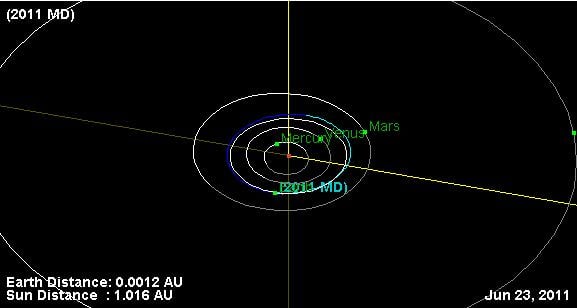[/caption] A newly discovered house-sized asteroid will miss the Earth by less than 17,700 km (11,000 miles) on Monday June 27, 2011. That's about 23 times closer than the Moon. The size and location of the asteroid, named 2011 MD, should allow observers in certain locations to take a look at the space rock, even with small telescopes. It's closest approach will be at 13:26 UTC on June 27.
- UPDATE 6/25
-
According to the latest info on JPL's Solar System Dynamics website, the closest approach has been updated to be Monday, June 27, at about 17:00 UTC. At that time it will be about 0.0001247 AU, or 18,665 km from the planet's center and about 12,280 km (about 7,500 miles) from its surface.
According to
Skymania,
2011 MD was found just yesterday, June 22, by LINEAR, a pair of robotic telescopes in New Mexico that scan the skies for Near Earth Asteroids.
As of now, asteroid 2011 MD is estimated to be between 9 to 45 meters (10 to 50 yards) wide. Dr. Emily Baldwin, of
Astronomy Now magazine,
said there is no danger of the asteroid hitting Earth, and even if it did enter the atmosphere, an asteroid this size would "mostly burn up in a brilliant fireball, possibly scattering a few meteorites."
JPL scientists agree. NASA's Asteroid Watch program at JPL wrote in a Twitter post on June 23rd saying, "There is no chance that 2011 MD will hit Earth but scientists will use the close pass as opportunity to study it w/ radar observations," adding later, "Asteroid 2011 MD measures about 10 meters. Stony asteroids less than 25 m would break up in Earth's atmosphere & not cause ground damage."
To find out updated information on 2011 MD's ephemeris, physical parameters and more, including an orbit diagram and close-approach data, see this page on
JPL's Solar System Dynamics website
.
 Universe Today
Universe Today
